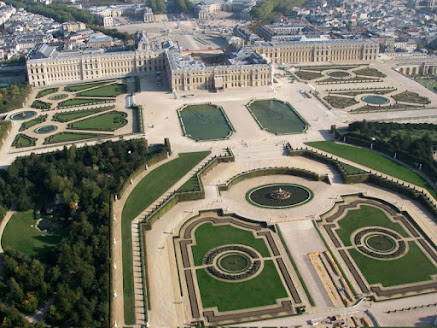Louis XIV transformed his father’s hunting lodge into the monumental Château de Versailles in the mid-17th century, and it remains France’s most famous and grandest palace.
===================================================================(in the city of Versailles, in the Île-de-France région of northern France) Situated in the leafy, bourgeois suburb of Versailles, some 22 kilometers (~14 miles) southwest of central Paris, the baroque château was the kingdom’s political capital and the seat of the royal court from 1682 until the fateful events of 1789 when revolutionaries massacred the palace guard. (Louis XVI and Marie Antoinette were soon dragged back to Paris, where they were ingloriously guillotined).
+ The Palace of Versailles never actually served the protective role of a medieval stronghold. Beginning in the Renaissance period, the term "chateau" was used to refer to the rural location of a luxurious residence, as opposed to an urban palace. It was thus common to speak of the Louvre "Palais” in the heart of Paris, and the "Château” of Versailles out in the country. (Versailles was only a village at the time.) Currently the centerpiece of Versailles' urban planning, the Palace now seems a far cry from the countryside residence it once was. Nevertheless, the garden end on the west side of the Estate of Versailles is still adjoined by woods and agriculture.
+ Under the guidance of Louis XIV, the residence was transformed (from 1661–1710) into an immense and extravagant complex surrounded by stylized French and English gardens. Every detail of its construction was intended to glorify the king. Landscape artist André Le Nôtre created symmetrical French gardens that included ornate fountains with “magically” still water, expressing the power of humanity (and, specifically, the king) over nature.
+ In the center of the Place d’Armes, facing the Avenue de Paris, is a bronze equestrian statue of Louis XIV. To the west is the Gate of Honor, a gilded iron gate and stone balustrade that marks the main entrance to the palace complex. Beyond that lies the broad expanse of the Court of Honor, bounded on the north and south by the Ministers’ Wings, outbuildings constructed in the 1680s to house the king’s secretaries of state.
+ Since 1979, the Palace of Versailles has been listed as a World Heritage site and is one of the greatest achievements in French 17th century art. Louis XIII's old hunting pavilion was transformed and extended by his son, Louis XIV, when he installed the Court and government there in 1682. A succession of kings continued to embellish the Palace up until the French Revolution. (Today the Palace contains 2,300 rooms.)
+ After the French Revolution, the Palace would never again be a royal residence and a new role was assigned to it in the 19th century, when it became the Museum of the History of France in 1837. The Palace was then devoted to housing new collections of paintings and sculptures representing great figures and important events that had marked the History of France.




No comments:
Post a Comment